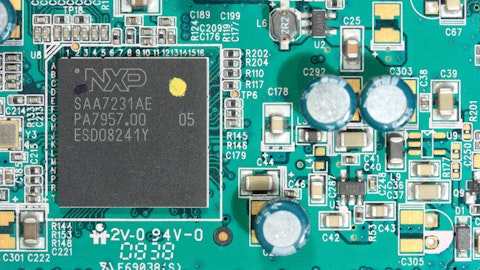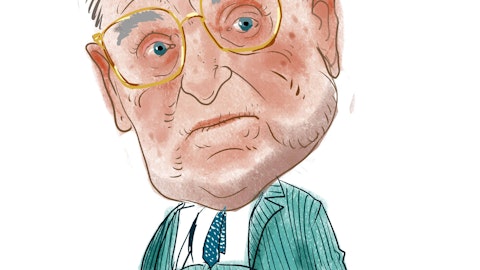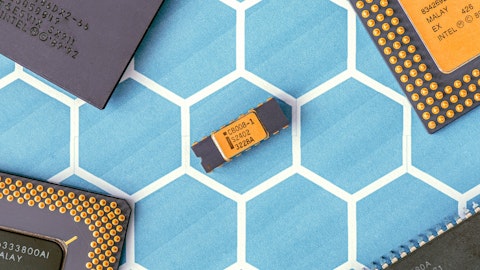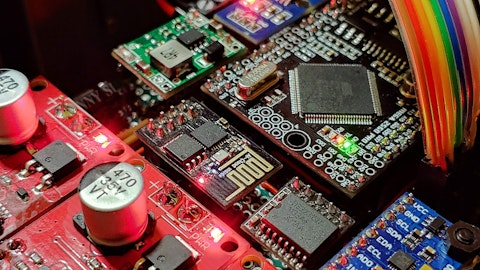Jed Dorsheimer: Great. And then just as my follow-up, if I look at the last quarter you saw a bump up in inventory and raw material saw I think the greatest increase quarter-over-quarter. This quarter you saw a slight increase, I think a $13 million in inventory. I don’t know the composition because the Q hasn’t been filed. I’m assuming that most of that is work in process, could you just give us some color on that? And where I’m going with this is just trying to back into the build-up of inventory from a wafer perspective. Thanks.
Gregg Lowe: Yeah, thanks, Jed. And let me give kind of a high level on that. And then Neill, can work through the details on this. We began working with our raw material suppliers in May of 2019. Getting ready for what is this big and transformative ramp in silicon carbide. We know that we were going to need to have them investing in their capacity to support this ramp and obviously, I think we’ve done a really good job of doing that. So some of this is all just thought getting material in place and capacity in place so that we’re not bottleneck kind of upstream, if you will.
Neill Reynolds: Yeah, and then from a numbers standpoint, Jed, that’s right. I don’t think there’s any big pickup in finished goods, primarily related to raw materials and WIP. So raw about ensuring we have enough raw material capacity to support the substrate ramp, as Gregg indicated. In addition, we’re supplying a lot of wafers out of the Durham, Building 10 from a 200-millimeter substrate capacity and set those up to Mohawk Valley that’s the other kind of tick-up in inventory as well. From a finished goods perspective, no, we’re not seeing much growth there, we’re still continuing to ship to customers really in the automotive side basically.
Operator: Thank you. And our next question go to Colin Rusch of Oppenheimer. Colin, please go ahead, your line is open.
Colin Rusch: Thanks so much. Gregg, you mentioned potential for folks to end up exiting the market. Can you talk a little bit about how discerning the customers are at this point around assessing that risk? And how impactful that is in terms of your design-wins and design-ins? Thank you.
Gregg Lowe: Cash I ask you to repeat that, it was really hard to hear you.
Colin Rusch: Okay, no problem. You talked about some folks exiting the market are failing in the market. And then, I’m curious about your customers’ ability to assess the risk of folks not being able to deliver on some of their commitments? And I’m wondering how impactful that is around your design in and design-win performance?
Gregg Lowe: Yeah, well, I would say that we are clearly the leader in silicon carbide technology, supply substrates to nearly all the device some folks out there and obviously feed those to ourselves. So having that strength really underpins their belief in our ability to ramp this technology. Like I said, I’ve been — I’m on weekly calls with executives and CEOs from our Tier 1 partners, our OEM customers et cetera and their consistent messages, they need more than they need it faster. And then they see that we’re ramping Mohawk Valley, they like us to ramp Mohawk Valley faster. But the one thing they see is that we have something called Mohawk Valley. We have the world’s largest 200-millimeter wafer fab, they’ve seen that.
We’ve been able to solve the crystal growth challenge for 200-millimeter and get Building 10 operating. That’s probably — that’s not probably that is the hardest thing to do and getting a silicon carbide MOSFET is getting the wafer and the substrate right. So I think it’s a matter of time for us demonstrating the 20% utilization out of Mohawk Valley. I think we’re pretty close on that. As Neill said, the Building 10 is feeding Mohawk Valley, now obviously at a higher rate than we’re utilizing out of Mohawk Valley. We’ve got plenty of inventory staged up there. So as we knock out these last couple of bottlenecks, I think we’re going to see a pretty nice pickup in Mohawk Valley. And then finally, I think it’s worth mentioning again the fact that we’ve had first past qualification on these MOSFETs coming out of new wafer fab and new wafer diameter and so forth.
Really points to the fundamental capability of this fab. It is not normal that you would have a 100% first pass success rate on all the MOSFETs product type, including a couple of modules. And I think that really – again you tend to see that fundamental capability.
Operator: Thank you. Our next question go to Vivek Arya of Bank of America. Vivek, please go ahead, your line is open.
Vivek Arya: Thanks for taking my question. Gregg, I just wanted to get your perspective on the next one to two years, there is just a lot of concern about more capacity coming online. I understand, maybe it’s not exactly the same quality as yours and maybe might not even have the same cost structure. But the fact of the matter is, there is a significant amount of whether it’s 150 or 200-millimeter capacity. So how do you look at that? Are you assuming that the market stays under-supplied for the next one or two years? Is it just rightly supplied? What are your assumptions about industry capacity for the next one to two years?
Gregg Lowe: I think from my viewpoint, there is going to be a supply-demand mismatch, there will be more demand than there will be supply certainly over the next couple of years and probably longer than that. I would repeat something that I said in our prepared remarks, this past quarter we recorded a record materials revenue. So there’s a lot of noise about different folks coming online, but the demand for our materials is very, very strong. And we’re — obviously constant communication with our materials customers any of them are looking for extension and expansion and things like that and then obviously, we just reported, the largest capacity reservation deposit in the history of semiconductors with our deal with Renesas.





